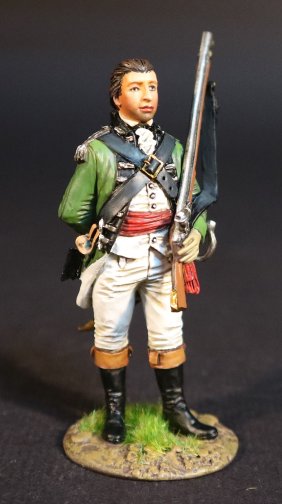- Joined
- Feb 2, 2011
- Messages
- 2,093
NEW RELEASES FOR DECEMBER 2023
THE EIGHTEENTH CENTURY COLLECTION
THE AMERICAN WAR OF INDEPENDENCE 1775 – 1783
THE BATTLE OF COWPENS, JANUARY 17[SUP]th[/SUP], 1781.
The Battle of Cowpens was an engagement during the American Revolutionary War fought on January 17[SUP]th[/SUP] 1781, near the town of Cowpens, South Carolina, between American forces under Brigadier General Daniel Morgan, and British forces under Lieutenant Colonel Banastre Tarleton, as part of the campaign in the Carolinas.
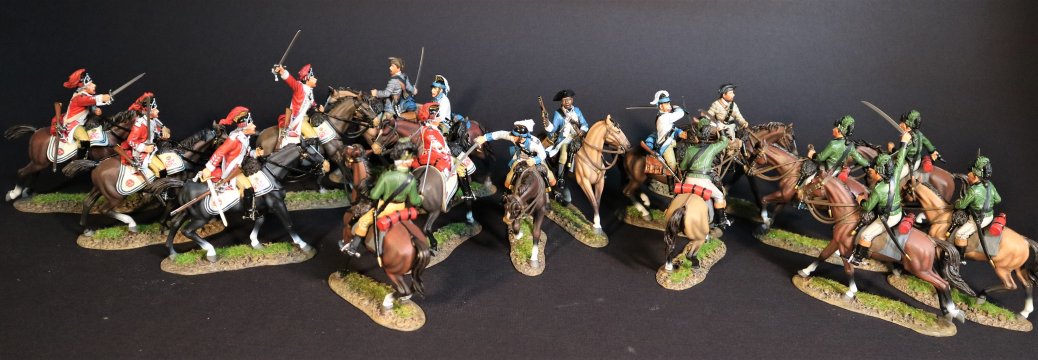
The battle was a turning point in the American reconquest of South Carolina from the British.
Tarleton’s force of 1,000 British troops were set against 2,000 troops under Morgan. Morgan’s forces suffered casualties of only 25 killed and 124 wounded. Tarleton’s force was almost completely eliminated with almost 30% casualties and 55% of his force captured or missing, with Tarleton himself and only about 200 British troops escaping.
Morgan’s forces conducted a double envelopment of the British forces, the only double envelopment of the war.
THE 17[SUP]th[/SUP] LIGHT DRAGOONS
Formed in 1759, the regiment was sent to Boston in 1775 to help quell the growing rebellion. Only a small part of the regiment was sent south and was attached to Tarleton’s command. They are said to have clung to the by now bedraggled scarlet coats that set them apart from the green uniformed Provincials of the British Legion.
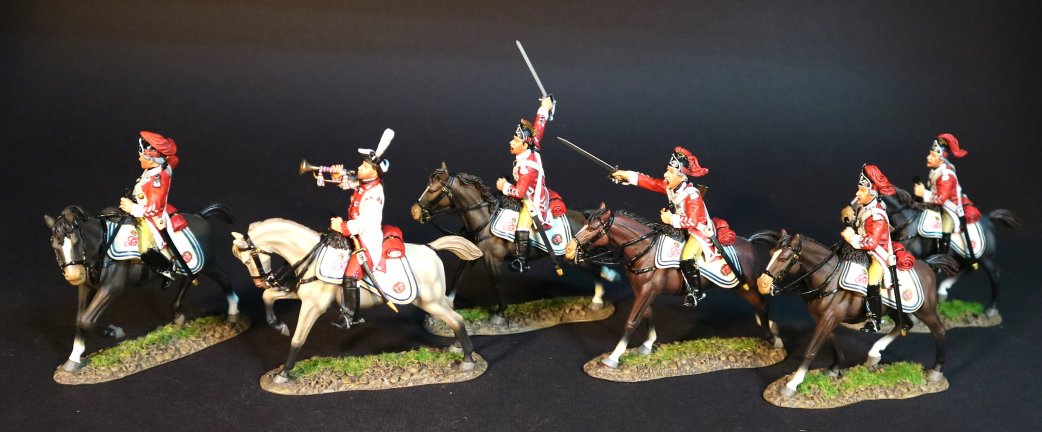
Only about a hundred dragoons were present at the Cowpens battle, and it was the only unit to retire from the battlefield in good order.
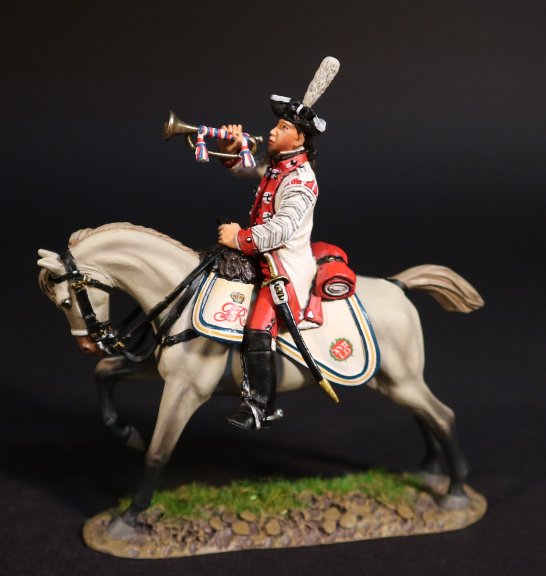
CW17-02
THE AMERICAN WAR OF INDEPENDENCE 1775 – 1783
THE BATTLE OF COWPENS, JANUARY 17[SUP]th[/SUP], 1781.
THE BRITISH ARMY,
THE 17[SUP]th[/SUP] LIGHT DRAGOONS.
MUSICIAN.
(2 pcs)
CONTINENTAL LINE INFANTRY
THE DELAWARE COMPANY.
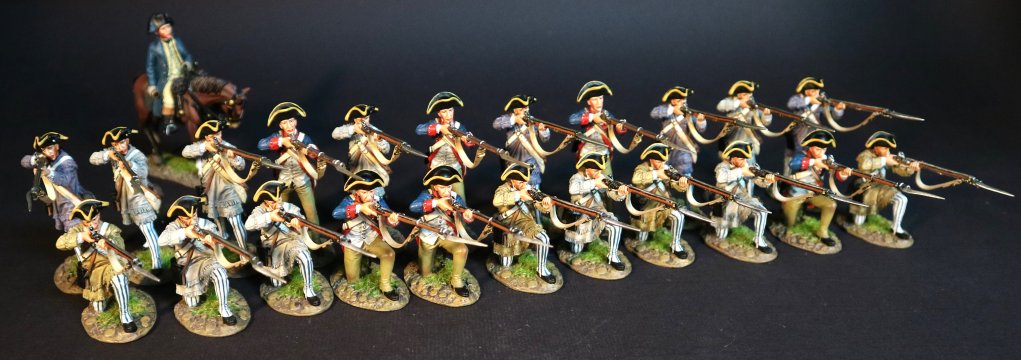
The main core of Morgan’s flying Army was a battalion of veteran Continentals. Three companies of the Maryland Line, and one company from Delaware. These were highly trained and disciplined, and formed the main line commanded by John Eager Howard. They were the best troops to engage in prolonged close combat with British regulars.
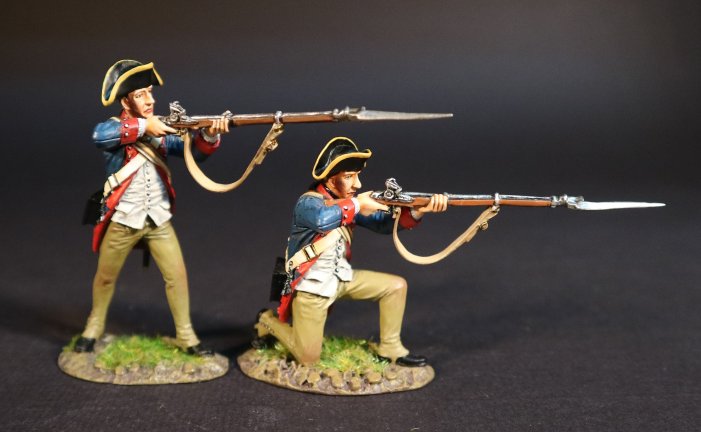
CWDEL-03
THE AMERICAN WAR OF INDEPENDENCE 1775 – 1783
THE BATTLE OF COWPENS, JANUARY 17[SUP]th[/SUP], 1781.
AMERICAN CONTINENTAL LINE INFANTRY,
THE DELAWARE COMPANY
(2 pcs)
The Delaware Company was especially highly regarded, and most were survivors from the Battle of Camden. Their commander, Captain Robert Kirkwood, was also well regarded.
Their full regimental issued uniforms were dark blue with red facings, cuffs and turn backs. Waistcoats were white and more durable buckskins replaced the white cotton breeches, and they wore cocked hats trimmed with yellow braid.
A black metal cannister which held forty extra cartidges was also added.
In October 1780, North Carolina, from its meagre stores, furnished the men of the Delaware company with new shoes, a hunting shirt, and blue striped ticking overalls. This was the uniform worn at Cowpens and subsequent actions, at Guilford Court House, Hobkirk’s Hill, the Siege of Ninety Six and Eutaw Springs.
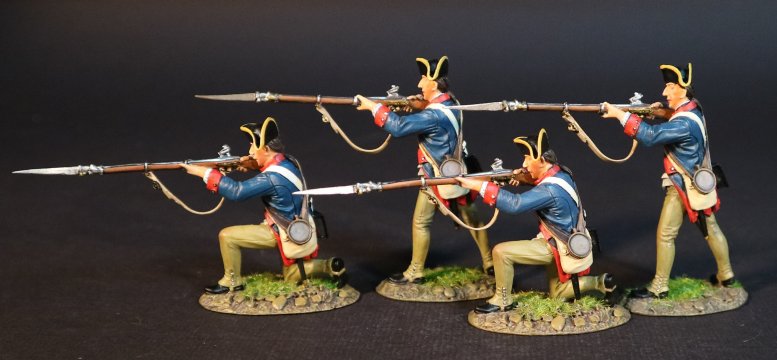
CWDEL-03N
THE AMERICAN WAR OF INDEPENDENCE 1775 – 1783
THE BATTLE OF COWPENS, JANUARY 17[SUP]th[/SUP], 1781.
AMERICAN CONTINENTAL LINE INFANTRY,
THE DELAWARE COMPANY
(4 pcs)
BRIGADIER GENERAL DANIEL MORGAN
The enigmatic Daniel Morgan was likely the best tactician of the war.
Born in New Jersey to James and Eleanor Morgan, a Welsh family, he became initially an officer in the Virginia Militia and at the start of the American Revolutionary War he recruited a company of riflemen.
He served in Benedict Arnold’s expedition to Quebec and in the Saratoga campaign. Also the Philadelphia campaign before resigning from the army in 1779.
He was to return to the army after the Battle of Camden, and led the Continental Army to victory at the Battle of Cowpens.
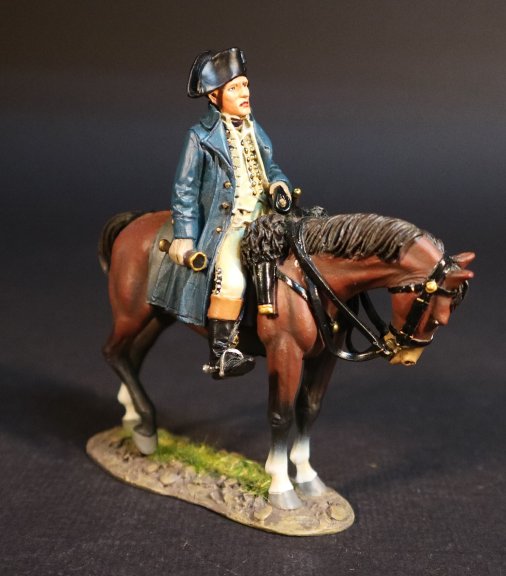
CWMORGAN
THE AMERICAN WAR OF INDEPENDENCE 1775 – 1783
THE BATTLE OF COWPENS, JANUARY 17[SUP]th[/SUP], 1781.
THE CONTINENTAL ARMY,
BRIGADIER GENERAL DANIEL MORGAN.
(2 pcs)
Morgan’s plan at the Battle of Cowpens took advantage of the British commander Tarleton’s tendency for quick action and his disdain for the American militia.
Morgan positioned his Virginia riflemen to the front, followed by the militia, and the regulars in reserve at the hilltop. The first two units were to withdraw as soon as they were seriously threatened, but only after inflicting some damage.
This it was planned would invite a premature charge from the British.
The tactic resulted in a double envelopment. As the British forces approached, the Americans, with their backs turned to the British, reloaded their muskets. When the British got close, they turned and fired at point blank range. In less than an hour, Tarleton’s 1,076 men suffered 110 killed and 830 captured, and 200 prisoners which were wounded. The British Legion among one of the best units in Cornwallis’s army, was rendered useless.
The captured commander of a battalion of the 71[SUP]st[/SUP] Regiment of foot, Archibald McArthur, said after the battle that, “he was an officer before Tarleton was born; that the best troops in the service were put under “that boy” to be sacrificed”.
For his actions, Virginia gave Morgan land and an estate that had been abandoned by a Tory.
THE EIGHTEENTH CENTURY COLLECTION
THE AMERICAN WAR OF INDEPENDENCE 1775 – 1783
THE BATTLE OF COWPENS, JANUARY 17[SUP]th[/SUP], 1781.
The Battle of Cowpens was an engagement during the American Revolutionary War fought on January 17[SUP]th[/SUP] 1781, near the town of Cowpens, South Carolina, between American forces under Brigadier General Daniel Morgan, and British forces under Lieutenant Colonel Banastre Tarleton, as part of the campaign in the Carolinas.

The battle was a turning point in the American reconquest of South Carolina from the British.
Tarleton’s force of 1,000 British troops were set against 2,000 troops under Morgan. Morgan’s forces suffered casualties of only 25 killed and 124 wounded. Tarleton’s force was almost completely eliminated with almost 30% casualties and 55% of his force captured or missing, with Tarleton himself and only about 200 British troops escaping.
Morgan’s forces conducted a double envelopment of the British forces, the only double envelopment of the war.
THE 17[SUP]th[/SUP] LIGHT DRAGOONS
Formed in 1759, the regiment was sent to Boston in 1775 to help quell the growing rebellion. Only a small part of the regiment was sent south and was attached to Tarleton’s command. They are said to have clung to the by now bedraggled scarlet coats that set them apart from the green uniformed Provincials of the British Legion.

Only about a hundred dragoons were present at the Cowpens battle, and it was the only unit to retire from the battlefield in good order.

CW17-02
THE AMERICAN WAR OF INDEPENDENCE 1775 – 1783
THE BATTLE OF COWPENS, JANUARY 17[SUP]th[/SUP], 1781.
THE BRITISH ARMY,
THE 17[SUP]th[/SUP] LIGHT DRAGOONS.
MUSICIAN.
(2 pcs)
CONTINENTAL LINE INFANTRY
THE DELAWARE COMPANY.

The main core of Morgan’s flying Army was a battalion of veteran Continentals. Three companies of the Maryland Line, and one company from Delaware. These were highly trained and disciplined, and formed the main line commanded by John Eager Howard. They were the best troops to engage in prolonged close combat with British regulars.

CWDEL-03
THE AMERICAN WAR OF INDEPENDENCE 1775 – 1783
THE BATTLE OF COWPENS, JANUARY 17[SUP]th[/SUP], 1781.
AMERICAN CONTINENTAL LINE INFANTRY,
THE DELAWARE COMPANY
(2 pcs)
The Delaware Company was especially highly regarded, and most were survivors from the Battle of Camden. Their commander, Captain Robert Kirkwood, was also well regarded.
Their full regimental issued uniforms were dark blue with red facings, cuffs and turn backs. Waistcoats were white and more durable buckskins replaced the white cotton breeches, and they wore cocked hats trimmed with yellow braid.
A black metal cannister which held forty extra cartidges was also added.
In October 1780, North Carolina, from its meagre stores, furnished the men of the Delaware company with new shoes, a hunting shirt, and blue striped ticking overalls. This was the uniform worn at Cowpens and subsequent actions, at Guilford Court House, Hobkirk’s Hill, the Siege of Ninety Six and Eutaw Springs.

CWDEL-03N
THE AMERICAN WAR OF INDEPENDENCE 1775 – 1783
THE BATTLE OF COWPENS, JANUARY 17[SUP]th[/SUP], 1781.
AMERICAN CONTINENTAL LINE INFANTRY,
THE DELAWARE COMPANY
(4 pcs)
BRIGADIER GENERAL DANIEL MORGAN
The enigmatic Daniel Morgan was likely the best tactician of the war.
Born in New Jersey to James and Eleanor Morgan, a Welsh family, he became initially an officer in the Virginia Militia and at the start of the American Revolutionary War he recruited a company of riflemen.
He served in Benedict Arnold’s expedition to Quebec and in the Saratoga campaign. Also the Philadelphia campaign before resigning from the army in 1779.
He was to return to the army after the Battle of Camden, and led the Continental Army to victory at the Battle of Cowpens.

CWMORGAN
THE AMERICAN WAR OF INDEPENDENCE 1775 – 1783
THE BATTLE OF COWPENS, JANUARY 17[SUP]th[/SUP], 1781.
THE CONTINENTAL ARMY,
BRIGADIER GENERAL DANIEL MORGAN.
(2 pcs)
Morgan’s plan at the Battle of Cowpens took advantage of the British commander Tarleton’s tendency for quick action and his disdain for the American militia.
Morgan positioned his Virginia riflemen to the front, followed by the militia, and the regulars in reserve at the hilltop. The first two units were to withdraw as soon as they were seriously threatened, but only after inflicting some damage.
This it was planned would invite a premature charge from the British.
The tactic resulted in a double envelopment. As the British forces approached, the Americans, with their backs turned to the British, reloaded their muskets. When the British got close, they turned and fired at point blank range. In less than an hour, Tarleton’s 1,076 men suffered 110 killed and 830 captured, and 200 prisoners which were wounded. The British Legion among one of the best units in Cornwallis’s army, was rendered useless.
The captured commander of a battalion of the 71[SUP]st[/SUP] Regiment of foot, Archibald McArthur, said after the battle that, “he was an officer before Tarleton was born; that the best troops in the service were put under “that boy” to be sacrificed”.
For his actions, Virginia gave Morgan land and an estate that had been abandoned by a Tory.



